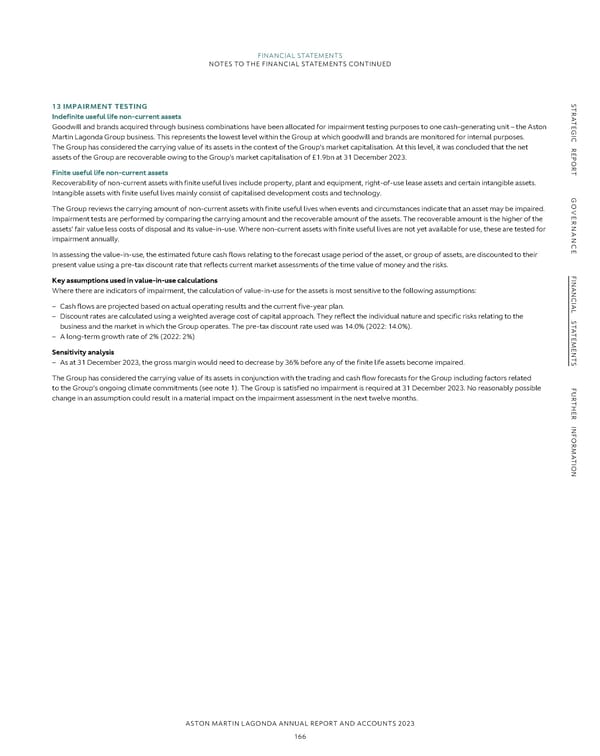FFIINANNANCCIALIAL S STTAATTEEMMEENNTTSS NOTES TO THE FINANCIAL STATEMENTS CONTINUED S 13 IMPAIRMENT TESTING TR Indefinite useful life non-current assets A Goodwill and brands acquired through business combinations have been allocated for impairment testing purposes to one cash-generating unit – the Aston TE G I Martin Lagonda Group business. This represents the lowest level within the Group at which goodwill and brands are monitored for internal purposes. C The Group has considered the carrying value of its assets in the context of the Group’s market capitalisation. At this level, it was concluded that the net R E assets of the Group are recoverable owing to the Group’s market capitalisation of £1.9bn at 31 December 2023. P O R Finite useful life non-current assets T Recoverability of non-current assets with finite useful lives include property, plant and equipment, right-of-use lease assets and certain intangible assets. Intangible assets with finite useful lives mainly consist of capitalised development costs and technology. G O The Group reviews the carrying amount of non-current assets with finite useful lives when events and circumstances indicate that an asset may be impaired. VE Impairment tests are performed by comparing the carrying amount and the recoverable amount of the assets. The recoverable amount is the higher of the R assets’ fair value less costs of disposal and its value-in-use. Where non-current assets with finite useful lives are not yet available for use, these are tested for NAN impairment annually. C In assessing the value-in-use, the estimated future cash flows relating to the forecast usage period of the asset, or group of assets, are discounted to their E present value using a pre-tax discount rate that reflects current market assessments of the time value of money and the risks. F I Key assumptions used in value-in-use calculations NAN Where there are indicators of impairment, the calculation of value-in-use for the assets is most sensitive to the following assumptions: C – Cash flows are projected based on actual operating results and the current five-year plan. IAL – Discount rates are calculated using a weighted average cost of capital approach. They reflect the individual nature and specific risks relating to the S T business and the market in which the Group operates. The pre-tax discount rate used was 14.0% (2022: 14.0%). A T – A long-term growth rate of 2% (2022: 2%) E M E Sensitivity analysis N T – As at 31 December 2023, the gross margin would need to decrease by 36% before any of the finite life assets become impaired. S The Group has considered the carrying value of its assets in conjunction with the trading and cash flow forecasts for the Group including factors related to the Group’s ongoing climate commitments (see note 1). The Group is satisfied no impairment is required at 31 December 2023. No reasonably possible F U change in an assumption could result in a material impact on the impairment assessment in the next twelve months. R T H E R INF OR M A T I ON ASTON MARTIN LAGONDA ANNUAL REPORT AND ACCOUNTS 2023 166
 Annual Report and Accounts Page 167 Page 169
Annual Report and Accounts Page 167 Page 169